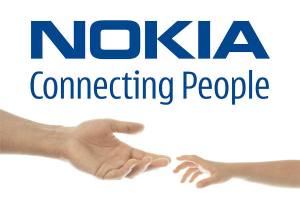
Apple has caught heat for its iPhone 4 external antenna design — wherein touching the lower-left portion of the phone can significantly reduce reception. Earlier today, Apple CEO Steve Jobs said that “We aren’t perfect” in regards to the antenna issue, and announced the company would be giving away free bumper cases to all iPhone 4 owners — which fixes the reception problem.
[aditude-amp id="flyingcarpet" targeting='{"env":"staging","page_type":"article","post_id":199404,"post_type":"story","post_chan":"none","tags":null,"ai":false,"category":"none","all_categories":"business,mobile,","session":"D"}']But while Apple would love for the topic of conversation to move on to other matters, Nokia took its chance to promote its own focus on antenna design. The company said that it was the “pioneer of internal antennas”, and that it has invested “thousands of hours” studying human phone usage behavior. It admitted that all mobile devices can have their antenna performance reduced with a “tight grip”, but it has developed ways of getting around that issue with dual antenna designs on the top and bottom of phones.
One could read Nokia’s statement as “our phones may be ugly, but at least they make calls.”
AI Weekly
The must-read newsletter for AI and Big Data industry written by Khari Johnson, Kyle Wiggers, and Seth Colaner.
Included with VentureBeat Insider and VentureBeat VIP memberships.
The technical victory is a small one for the company, however, when you consider that its market value has fallen by $77 billion since the debut of the iPhone in 2007. The company has yet to introduce a legitimate smartphone competitor to the iPhone and popular Android phones like the Motorola Droid. It recently announced that it would be focusing on Symbian and MeeGo — a mobile operating system it developed with Intel — instead of developing an Android phone.
You can read Nokia’s full statement below:
Antenna design is a complex subject and has been a core competence at Nokia for decades, across hundreds of phone models. Nokia was the pioneer in internal antennas; the Nokia 8810, launched in 1998, was the first commercial phone with this feature.
Nokia has invested thousands of man hours in studying human behavior, including how people hold their phones for calls, music playing, web browsing and so on. As you would expect from a company focused on connecting people, we prioritize antenna performance over physical design if they are ever in conflict.
In general, antenna performance of a mobile device/phone may be affected with a tight grip, depending on how the device is held. That’s why Nokia designs our phones to ensure acceptable performance in all real life cases, for example when the phone is held in either hand. Nokia has invested thousands of man hours in studying how people hold their phones and allows for this in designs, for example by having antennas both at the top and bottom of the phone and by careful selection of materials and their use in the mechanical design.
VentureBeat's mission is to be a digital town square for technical decision-makers to gain knowledge about transformative enterprise technology and transact. Learn More
